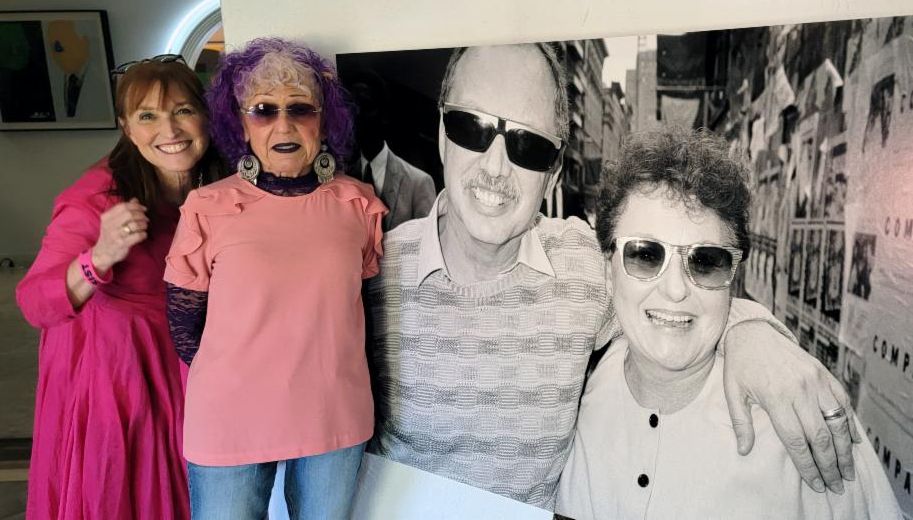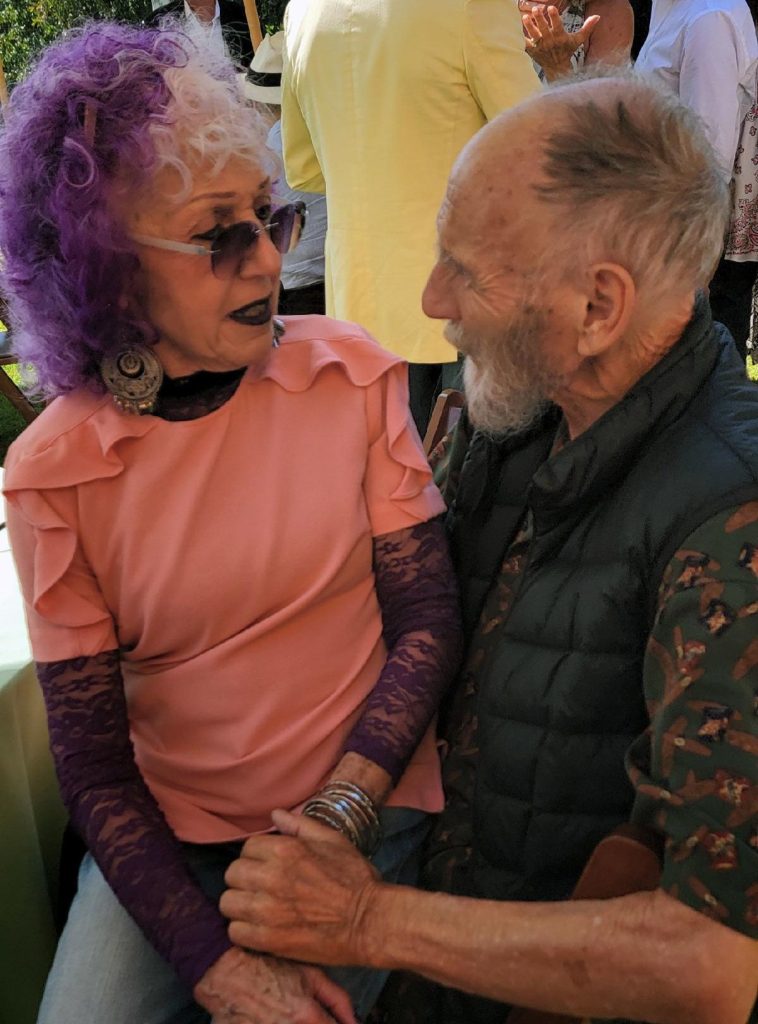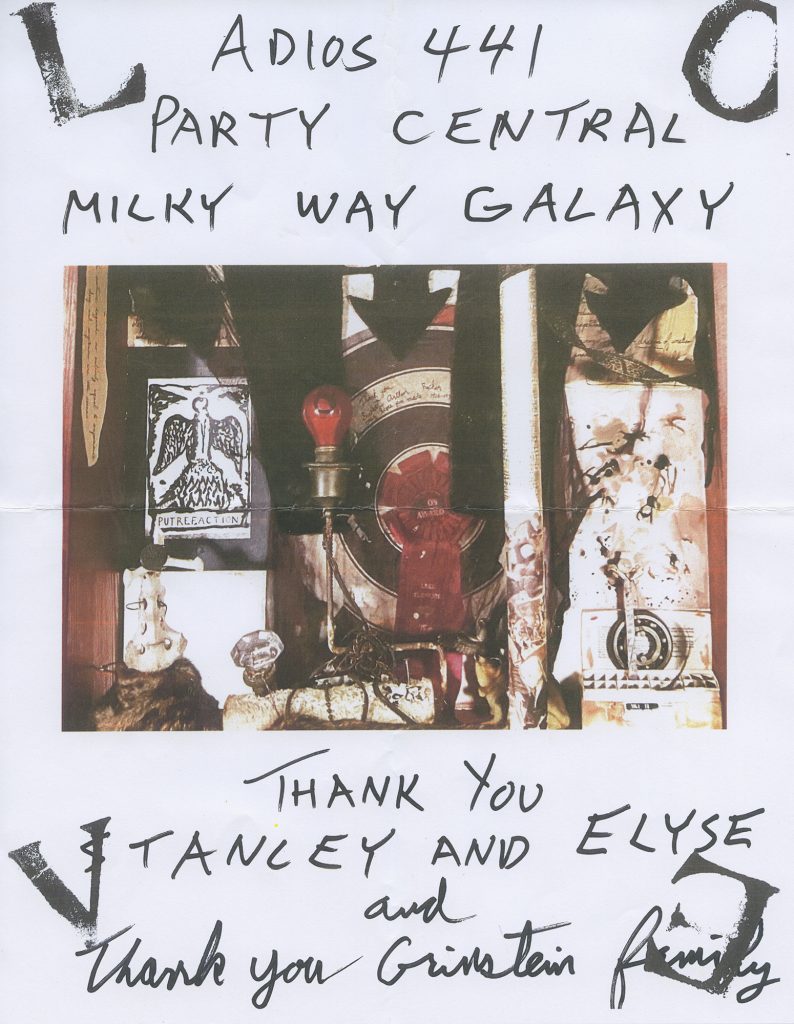

Judy Chicago in front of Rockingham, 2022. Photo © Donald Woodman/ARS, NY
Our short trip to Los Angeles was precipitated by a party commemorating the sale of the house on Rockingham which was owned by Stanley and Elyse Grinstein, my first patrons and lifelong friends. The house was legendary for its artist parties, the first of which I attended in 1965. It was for Larry Bell who, after some urging from me, flew in from Taos with his life partner, Janet Webb. The relationship Larry and I have built over the decades gives me great pleasure as we have watched each other’s careers ebb and flow and finally, in the last chapter of our respective lives, blossom. I’ve known the three Grinstein daughters, Nancy, Ellen and Ayn, since they were young and because Stanley used to refer to me as his ‘fourth daughter’, they view me as their sister. The four of us spoke about their parents and the house in the back garden which was full of artists who were nurtured by – and loved – the Grinsteins.

(Top) Ellen Grinstein and Judy Chicago next to a photograph of Stanley and Elyse Grinstein, 2022 (Left) Judy Chicago and Larry Bell, 2022. (Right) The Grinstein daughters Nancy, Ellen, and Ayn with Judy Chicago at the Rockingham farewell party, 2022. Photos © Donald Woodman/ARS, NY
As long as we were going to L.A. we planned some other activities, as we don’t get there often. As soon as we got off the plane in Los Angeles, we went directly to LACMA to see the Barbara Kruger show in which the artist reconceived many of her early pieces via new media, which was interesting. We were toured by the co-curator, Rebecca Morse, while her boss, museum director Michael Govan, was quarantined in a NY hotel room with COVID. There was something funny about having to call him in order to reach Rebecca so that we could meet outside the exhibition. The new disease-inflected world, I guess.
The next day we visited the Hammer to see the Andrea Bowers show, which was very moving, especially the hand drawn tributes to mostly unacknowledged people. Somehow, the hours of pencil on paper bestowed upon them an importance that was generally denied to them in real life. Annie Philbin, museum director, hosted a wonderful lunch at the Alice Waters restaurant, Lulu, where she, Connie Butler (curator extraordinaire), Andrea, Donald and I gathered together, along with our friend, novelist Kevin Kwan. During the lunch, Annie asked if I’d like to meet Gary Tinterow, director of the Houston museum, who was eating there with two colleagues. As I didn’t know him, I said “sure”.
(Left) Annie Philbin, Judy Chicago, and Connie Butler at lunch, 2022. (Right) Andrea Bowers signs her book for Judy Chicago, 2022. Photos © Donald Woodman/ARS, NY
Turns out he was dining with the former director of the Louvre, who seemed very unimpressed by the fact that when Donald and I were in Paris for the Dior show, we had been able to see the overly crowded Michaelangelo drawing show at 8 AM courtesy of Olivier Bialobos, Director of Global Communications for Dior and one of my favorite people in the world. Seated next to him was the director of the National Gallery of Australia. As I was about to leave, he jumped up and started stammering out something like: “I came here to tour the 13 most important art institutions in the U.S. and now I’ve met the 14th”, an odd comment that I basically blew off. Then (more stammering); “Could I bother you….could I bother you (etc)…for a photo as my curators will be furious if they realized I had met you and didn’t get a photo.”
Things like this happen to me all the time (though usually not from such stellar sources) and I try to be gracious, something I learned from my mentor, diarist Anais Nin, who was one of the most gracious people of all time. After lunch, Andrea gave us a private tour of her exhibition and signed a catalog for me, which I shall treasure as her inscription acknowledged my influence on her practice, which meant the world to me.
Judy Chicago hanging out with Kevin Kwan, 2022. Photo © Donald Woodman/ARS, NY
The next evening, we had dinner with Kevin and a friend at Michael’s, a restaurant in Santa Monica where I’ve gone since the 1970s when it first opened. The owner, Michael McCarthy, was friends with all the male artists in L.A. and their photos grace the bathrooms of both his California and New York restaurants (many taken by Dennis Hopper who was not the nicest person around though he was a good photographer). It seemed fitting to pay tribute to a specific table in the restaurant garden where Stanley and Elyse often went, accompanied by a changing array of artists, including us.
After a delicious dinner in Michael’s unique garden, we hung out with Kevin, who we met at a time when both of our lives were changing in that we were becoming much more visible. Navigating some of the challenges of fame has been the subject of our many conversations. Although I feel very lucky to be receiving so much recognition, I have spent many decades working quietly in my studio, something that has become increasingly difficult as a result of the intensifying interest in my work. At the same time, I am deeply heartened by the fact that finally, my large body of art is emerging from the shadow of The Dinner Party, where it languished for too many years.


(Top) Judy Chicago sitting on George Herm’s lap, 2022. Photo © Donald Woodman/ARS, NY (Bottom) George Herm’s hand-made party favor, 2022
The next day was the party commemorating the end of Rockingham, the house that had provided so many of us with lodging, friendship and fun. I was glad when I moved away from L.A. because it meant that I could stay at the house, something I couldn’t do while I still lived there. One of my favorite activities was sitting on Stanley and Elyse’s bed (where they often held court) and visiting, not to mention gossiping. The legendary artist George Herms was at the party and he had thoughtfully made special party favors for everyone. When I saw him, he pulled me onto his lap and I mentioned the last time I had seen him; at the 2007 opening of WACK at LAMoCA, the first show (curated by Connie Butler) exploring the major influence feminism had on the art world (which – up until that time – basically ignored that).
At that time, George had waved his hand, indicating everyone at the opening, and said: “Judy, you did all of this”, referencing my years of teaching, organizing and advocating for women artists in southern California (also unacknowledged at that time). As I said in my remarks at the Rockingham party, if that were true, it all began in the Grinsteins’s living room where – in 1971 – I gave my first lecture about my experiences in the LA art scene of the 1960s, which was definitely male-centered and unwelcoming to female-identified artists. That talk became the basis of my first autobiography, Through the Flower and is also referenced in my definitive autobiography, The Flowering, which was published last year by Thames and Hudson
One funny note (or not so funny if you think about it) was that other than Lita Albuquerque – who was not prominent in the 1960s – I was the only woman artist at the party, which brought back memories of how alienated I felt then. It was quite a contrast with the warmth with which I was greeted, except by the artists Joe Goode (who was hostile; I have no idea why as were friendly neighbors in the 1960s) and Billy Al Bengston (who influenced me despite himself). Sadly, dementia has rendered Billy Al even more antagonistic than he had been when he was young.
Judy Chicago, Ode to Rockingham, 2022. © Judy Chicago/Artist Rights Society (ARS) New York; Photo © Donald Woodman/ARS, NY
We were scheduled to have dinner with Jeffrey Deitch (after the party) and I had invited him to see the house before it is demolished by the developers who bought it for the land and will surely tear it down, despite its incredible 50 year history. Surprisingly, he had never been there and he enjoyed touring it and seeing so many people that he knew, including Frank Gehry, who was my first landlord. I lived in a house he owned in Santa Monica at a time when he was first experimenting with his small bungalow. Additionally, his sister married Rolf Nelson, my first art dealer which was a disaster as Rolf was clearly gay (though not out).
The next day, Donald and I flew home and back to the day to day struggle to wrest some focused studio time out of all the demands that vie for my time. I hope that my readers enjoy a few glimpses into my present life, which is exciting, exhausting and challenging – all at the same time. After all, as I often say: “I may not LOOK 83 or ACT 83 but I AM 83″ and I don’t have the same prodigious energy as I had when I was young.
Judy Chicago sitting on a bed with Elyse and Stanley Grinstein in Brentwood, CA, 1997. Photo courtesy Through the Flower Archives housed at Penn State University Archives